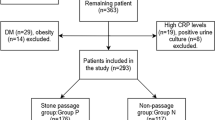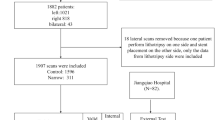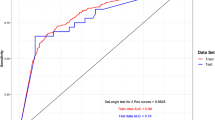Abstract
In this study, a prototype artificial neural network model (ANN) was used to estimate the stone passage rate and to determine the effectivity of predictive factors on this rate in patients with ureteral stones. The retrospective study included a total of 192 patients with ureteral stones, comprising 128 (66.7%) men and 64 (33.3%) women. Patients were divided into two groups. Group 1 (n: 125) consisted of people who spontaneously passed their stones, Group 2 (n: 67) consisted of people who could not pass stones spontaneously. The groups were compared with regard to the relationship between input data and stone passage rate by using both ANN and standard statistical tests. To implement the ANN, the patients were randomly divided into three groups: (a) training group (n = 132), (b) validation group (n = 30), and (c) test group (n = 30). The accuracy rate of ANN in the estimation of the stone passage ratio was 99.1% in the group a, 89.9% in the group b, and 87.3% in the group c. It was revealed that certain criteria (stone size, body weight, pain score, ESR, and CRP) were relatively more significant for saving treatment cost and time and for avoiding unnecessary treatment. ANN can be highly useful for the avoidance of unnecessary interventions in patients with ureteral stones as it showed remarkably high performance in the estimation of stone passage rate (99.16%).

Similar content being viewed by others
References
Pearle MS, Lotan Y (2012) Urinary lithiasis: etiology, epidemiology, and pathogenesis. In: Wein AJ, Kavoussi LR, Novick AC, Partin AW, Peters CA (eds) Campbell-walsh urology, 10th edn. Elsevier, Philadelphia, pp 1257–1286
Segura JW, Preminger GM, Assimos DG, Dretler SP, Kahn RI, Lingeman JE et al (1997) Ureteral stones clinical guidelines panel summary report on the management of ureteral calculi. J Urol 158:1915–1921 (The American Urological Association)
Aldaqadossi HA (2013) Stone expulsion rate of small distal ureteric calculi could be predicted with plasma C-reactive protein. Urolithiasis 41:235–239
Sfoungaristos S, Kavouras A, Katafigiotis I, Perimenis P (2012) Role of white blood cell and neutrophil counts in predicting spontaneous stone passage in patients with renal colic. BJU Int 110(8 Pt B):E339–E345
Ahmed AF, Gabr AH, Emara AA, Ali M, Abdel-Aziz AS, Alshahrani S (2015) Factors predicting the spontaneous passage of a ureteric calculus of < 10 mm. Arab J Urol 13:84–90
Fazlioglu A, Salman Y, Tandogdu Z, Kurtulus FO, Bas S, Cek M (2014) The effect of smoking on spontaneous passage of distal ureteral stones. BMC Urol 14:27
Lawrence J (1994) Introduction to neural networks, design, theory and applications. California Scientific Software Press, Nevada City
Akinsal EC, Haznedar B, Baydilli N, Kalinli A, Ozturk A, Ekmekçioğlu O (2018) Artificial neural network for the prediction of chromosomal abnormalities in azoospermic males. Urol J 15(3):122–125. https://doi.org/10.22037/uj.v0i0.4029
Seckiner I, Seckiner S, Sen H, Bayrak O, Dogan K, Erturhan S (2017) A neural network-based algorithm for predicting stone-free status after ESWL therapy. Int Braz J Urol 43(6):1110–1114. https://doi.org/10.1590/s1677-5538.ibju.2016.0630
Aminsharifi A, Irani D, Pooyesh S, Parvin H, Dehghani S, Yousofi K, Fazel E, Zibaie F (2017) Artificial neural network system to predict the postoperative outcome of percutaneous nephrolithotomy. J Endourol 31(5):461–467. https://doi.org/10.1089/end.2016.0791(Epub 2017 Mar 13. Erratum in: J Endourol. Jun;31(6):621)
Kuo RJ, Huang MH, Cheng WC, Lin CC, Wu YH (2015) Application of a two-stage fuzzy neural network to a prostate cancer prognosis system. Kuo Artif Intell Med 63(2):119–133. https://doi.org/10.1016/j.artmed.2014.12.008(Epub 2014 Dec 30)
Hubner WA, Irby P, Stoller ML (1993) Natural history and current concepts for the treatment of small ureteral calculi. Eur Urol 24:172
Ueno A, Kawamura T, Ogawa A et al (1977) Relation of spontaneous passage of ureteral calculi to size. Urology 10:544
Iqbal Nadeem, Malik Yashfeen, Nadeem Utbah, Khalid Maham, Pirzada Amna, Majeed Mehr, Malik Hajra Arshad, Akhter Saeed (2018) Comparison of ureteroscopic pneumatic lithotripsy and extracorporeal shock wave lithotripsy for the management of proximal ureteral stones: a single center experience. Turk J Urol 44:221–227. https://doi.org/10.5152/tud.2018.41848
Author information
Authors and Affiliations
Corresponding author
Ethics declarations
Conflict of interest
All authors declare no potential conflicts of interest.
Ethical approval
The study was approved by the local ethics committee (Approval No: 2018/10-03).
Human and animal rights and informed consent
This article does not contain any studies with human or animal subjects performed by any of the authors.
Additional information
Publisher's Note
Springer Nature remains neutral with regard to jurisdictional claims in published maps and institutional affiliations.
Rights and permissions
About this article
Cite this article
Solakhan, M., Seckiner, S.U. & Seckiner, I. A neural network-based algorithm for predicting the spontaneous passage of ureteral stones. Urolithiasis 48, 527–532 (2020). https://doi.org/10.1007/s00240-019-01167-5
Received:
Accepted:
Published:
Issue Date:
DOI: https://doi.org/10.1007/s00240-019-01167-5




